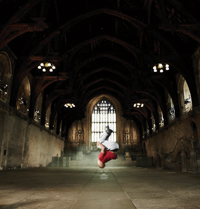Lucy Shaw explains the challenges of devising and programming creativity into the historic settings of the Houses of Parliament

Working on new public arts initiatives always presents challenges and developing a new creative programme of public performances and exhibitions in Westminster Hall, the oldest remaining part of the Palace of Westminster, has certainly provided them. There are the early stages of advocacy work: ensuring people understand the objectives and motivations of the programme; planning a legacy; and, perhaps the most important aspect, ensuring that participants and audiences get a high quality arts experience.
It is very significant that during such a historic summer, this prestigious space will feature some of the best artistic talent from around the UK in performances and exhibitions. It is an opportunity for arts organisations, particularly those working with young people, to express their work in the heart of our democracy and in front of public audiences. For them to be able to say they have performed in a space that has seen the trial of Guy Fawkes, as well as the more recent state addresses by President Obama and the Queen, is something completely unique! The programme features Cultural Olympiad projects where themes of democracy or political heritage are the focus, and the work showcases ‘voice’ in a range of artistic mediums, raising questions and demonstrating the diverse creative thoughts of different communities. Westminster Hall has been a changing space throughout history, and I hope the diversity and vibrancy of the programme will add to its cultural legacy and demonstrate Parliament’s sense of participation, appreciation of audience and its commitment to the wider community.
Presenting this work in Parliament creates the logistical challenge of implementing work in a non-arts space and being sensitive to the role and functions of that space – in this case a working legislature. Parliament is an essential part of our nation’s politics. It examines and challenges the work of Government, passing laws and ensuring debate about legislation, so there are vast amounts of protocol and many stakeholders to communicate with. Westminster Hall is also a UNESCO World heritage site and Grade 1 listed building and its use must be approved by the Serjeant at Arms, Black Rod and the Monarch. A major task has been to communicate the programme’s content and structures internally to ensure all permissions were granted, whilst at the same time making sure the focus was on creating an innovative and welcoming programme of arts work.
The motivation behind the initial idea of an arts programme came from the work that Parliament is doing to engage the public, ranging from an education service which engages schools across the UK in the role and work of Parliament to a busy tours programme for visitors. But Parliament wanted to devise an engagement programme using the London 2012 Games as a catalyst – one that was centred around the arts and would make synergies between the work of the Cultural Olympiad and the London 2012 Festival to bring new audiences into Parliament and to welcome people during the summer. Programming the work alongside Parliamentary business has been complex: some of it is taking place while the house is sitting, but other work is during summer opening, Parliament’s busiest period when many people come on full tours. Other challenges have been in communicating and managing complex relationships both internally and externally, and being reactive to the new issues that arise, negotiating solutions and reaching agreements that satisfy all involved. It is particularly important that members of both houses have opportunities to engage with the project and we have been linking MPs with their constituents taking part in Arts in Parliament, as well as inviting them to attend events and engaging them in the development process. An Arts in Parliament Advisory Group comprising both MPs and Peers has been helping with governance and advising on elements of the programme.
I hope in the future that other work can take place in Westminster Hall as a result of this programme. So far the positive feedback from participants and partners, and from internal and external audiences, has been incredible. There is something for everyone in the programme and the added thrill of its setting in the Houses of Parliament will be contributing to the celebration and excitement throughout the summer.
Arts in Parliament events are all free and open to the public, though some require tickets which can be booked at www.parliament.uk/artsinparliament




